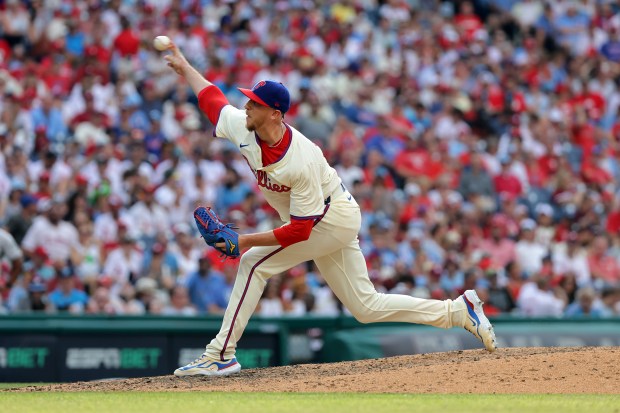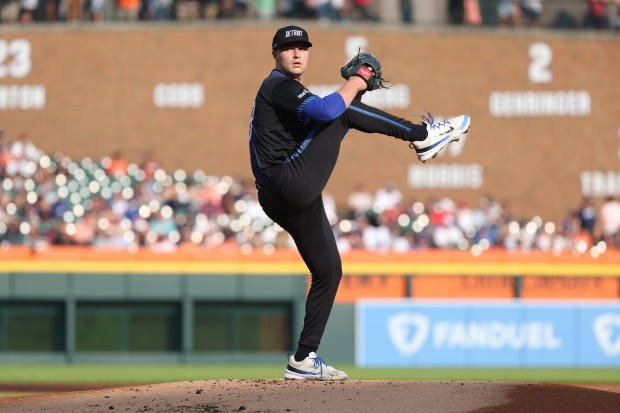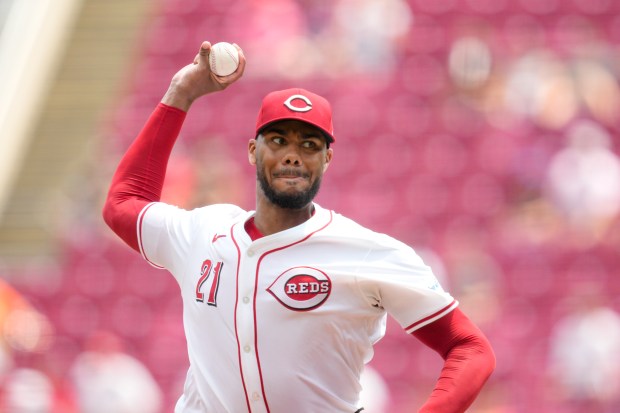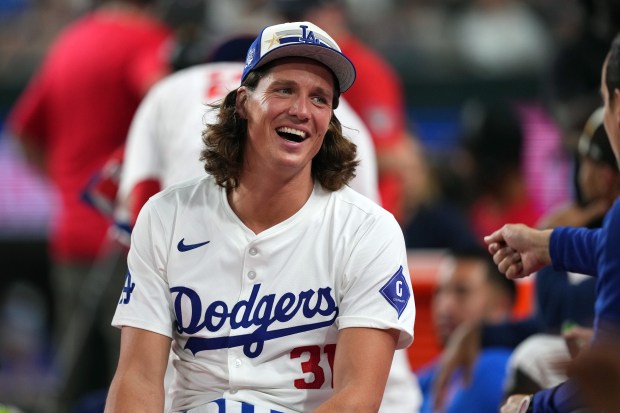ARLINGTON, Texas — A parade of pitchers throwing triple-digit fastballs was the likely scenario heading into Tuesday night’s All-Star Game, starting with National League starter Paul Skenes.
Velocity is the name of the game in baseball these days, as evidenced by the radar gun readings in the Midsummer Classic.
Could we soon be looking at a day when an average regular-season game features pitchers on both sides all dealing with 100 mph fastballs?
“I believe so,” Cincinnati Reds ace Hunter Greene said before Tuesday’s game. “You see the uptick in velo every year, or every three to five years. It’s inevitable. The future is coming, and guys are getting stronger, they’re maturing faster, and understanding the right routines they need to be successful. I do think we’ll see it.”
Not everyone has the size, talent and control to succeed, of course, but the ones who do are changing the way the game is played.
Oakland A’s closer Mason Miller, who ranked second in the majors with an average of 100.9 mph on his four-seamer, said Monday he might try to beat his personal best of 103.7 mph in the controlled environment of Globe Life Field.
“We can hope,” he said. “I don’t want to get too wild. I don’t want to hit anybody so I want to keep it within range, But I want to get it up there.”
On a night when all-time fireballer Nolan Ryan was part of the pregame ceremonies, the question of how high it could go had to be asked.
“What did they use to say, ‘No one can throw over 104 (mph)?’” said Los Angeles Dodgers starter Tyler Glasnow, who is here for the All-Star festivities but is on the injured list. “But that’s not true, I guess. I have no idea. I think 105 is the obvious stopping point, but I’m sure someone will drop a 106 at some point.”
Aroldis Chapman, whom Greene acknowledged is the “Godfather of Velo,” threw a 105.8 mph fastball in 2010, the hardest pitch ever registered in the Statcast Era, which dates back to 2008.
This All-Star Game could be the wave of baseball’s future — a series of pitchers throwing an inning apiece with fastballs that register at or near the triple-digits.
“For now I think it‘s an anomaly,” Miller said. “We’re seeing velocity creep up in college, and creep up in pros. Time will tell. Ten years ago it was Aroldis Chapman, and that was it. Then it was Jordan Hicks and some other guys came along. Now it’s a handful of guys. Who knows about 10 years from now?”
Los Angeles Angels pitcher Ben Joyce threw a 104.5 mph fastball last week against the Seattle Mariners, becoming the fourth pitcher to hit that mark since the start of pitch-tracking in ’08. Chapman, Hicks and Jhoan Durán also reached the mark.
Naturally the harder pitchers throw, the more difficult it is for hitters to hit, especially if you can complement it with a solid offspeed pitch.

Philadelphia has an arsenal of relievers who throw in the upper 90s, including All-Stars Jeff Hoffman and Matt Strahm. Hoffman admitted it was deflating not to hit 100 mph in their bullpen.
“When you see (Phillies closer José) Alvarado go out there and do it with his eyes closed, yeah it is a little bit,” Hoffman said before the game.
The MLB season batting average of .243 heading into the break was third-lowest since the dead ball era, ahead of 2022 and 1968, the so-called “Year of the Pitcher.” Hoffman called it “simple math.”
“As velocity goes up, averages go down,” he said. “It’ll eventually get to the point where it will be more and more 100 (mph) guys until it’s the whole bullpen. That’s kind of where we are right now. (Strahm) is at 95. It’s not like he’s 91.”
So is it good for the game?
Commissioner Rob Manfred pushed for rules changes to add offense, including eliminating the shift and limiting pick-off throws to help base stealing. But the numbers suggest that velocity trumps any attempt to add offense.
“In terms of runs per game, we’re exactly where we were last year,” Manfred said Tuesday. “This year in terms of offense, we have seen a significant uptick in June and July as the weather has gotten warmer …
“Having said that, the decline in offense is something we’ve paid a lot of attention to and will continue to monitor as to whether we need to do something. You do hear a lot of chatter about the dominance of pitching in the game, and that’s absolutely true.”

Some fans don’t mind watching a well-pitched game instead of a slugfest, even if contact rates have been on the decline for years.
“It depends on what you want to see,” Glasnow said. “People like the art of pitching, and they might want to see a slower velocity game with more carving. People who love the adrenaline-pumping kind of stuff probably love the velo. So it depends on who you ask.”
According to an Associated Press report, the average four-seam fastball velocity of 94.2 mph matched 2023 and was up from 91.1 mph in 2008. The number of 100 mph or higher pitches went from 214 in ’08 to 3,880 in 2023.
Detroit’s Tarik Skubal said it doesn’t necessarily mean that all pitchers will try to throw around 100 mph in the future.
“It’s really hard to do,” he said. “I think it will plateau.”
Glasnow agreed, saying “some guys coming up (from the minors) are doing better and not throwing so hard. I think you have to have a unique 90-93 (mph fastball). But results dictate everything, so if you come up and do well, you probably can continue.”

Hoffman said organizations are drafting bigger and bigger pitchers, which increases the arm strength and velocity. Would there still be room for crafty soft-tossers like Kyle Hendricks?
“Sure, because as the ceiling goes up, and if the floor stays the same … usually you want to stay out of the middle range,” Hoffman said. “If you’re above it or below it, you’re good. Just stay away from the MLB average.”
Either way, the competition to keep topping each other will be around for a while, and Skenes’ comet-like trajectory will no doubt inspire kids to keep throwing harder.
“It’s a secondary thing, maybe,” Miller said. “It’s a nice little, bragging right. But if you’re not performing or doing well for your team week in and week out, it’s just moot.”



